Ancient history
Germanic peoples occupied much of the present-day territory of Germany in ancient times. The Germanic peoples are those who spoke one of the Germanic languages, and they thus originated as a group with the so-called first sound shift (Grimm’s law), which turned a Proto-Indo-European dialectinto a new Proto-Germanic language within the Indo-European language family. The Proto-Indo-European consonants p, t, and k became the Proto-Germanic f, [thorn] (th), and x (h), and the Proto-Indo-European b, d, and g became Proto-Germanic p, t, and k. The historical context of the shift is difficult to identify because it is impossible to date it conclusively. Clearly the people who came to speak Proto-Germanic must have been isolated from other Indo-Europeans for some time, but it is not obvious which archaeological culture might represent the period of the shift. One possibility is the so-called Northern European Bronze Age, which flourished in northern Germany and Scandinavia between about 1700 and 450 BC. Alternatives would be one of the early Iron Age cultures of the same region (e.g., Wessenstadt, 800–600 BC, or Jastorf, 600–300 BC).
Evidence from archaeological finds and place-names suggests that, while early Germanic peoples probably occupied much of northern Germany during the Bronze and early Iron ages, peoples speaking Celtic languages occupied what is now southern Germany. This region, together with neighbouring parts of France and Switzerland, was the original homeland of the Celtic La Tèneculture. About the time of the Roman expansion northward, in the first centuries BC and AD, Germanic groups were expanding southward into present-day southern Germany. The evidence suggests that the existing population was gradually Germanized rather than displaced by the Germanic peoples arriving from the north.
Solid historical information begins about 50 BC when Julius Caesar’s Gallic Wars brought the Romansinto contact with Germanic as well as Celtic peoples. Caesar did cross the Rhine in 55 and 53 BC, but the river formed the eastern boundary of the province of Gaul, which he created, and most Germanic tribes lived beyond it. Direct Roman attacks on Germanic tribes began again under Nero Claudius Drusus Germanicus, who pushed across the Rhine in 12–9 BC, while other Roman forces assaulted Germanic tribes along the middle Danube (in modern Austria and Hungary). Fierce fighting in both areas, and the famous victory of the Germanic leader Arminius in the Teutoburg Forest in AD 9 (when three Roman legions were massacred), showed that conquering these tribes would require too much effort. The Roman frontier thus stabilized on the Rhine and Danube rivers, although sporadic campaigns (notably under Domitian in AD 83 and 88) extended control over Frisia in the north and some lands between the Rhine and the upper Danube.
Both archaeology and Caesar’s own account of his wars show that Germanic tribes then lived on both sides of the Rhine. In fact, broadly similar archaeological cultures from this period stretch across central Europe from the Rhine to the Vistula River (in modern Poland), and Germanic peoples probably dominated all these areas. Germanic cultures extended from Scandinavia to as far south as the Carpathians. These Germans led a largely settled agricultural existence. They practiced mixed farming, lived in wooden houses, did not have the potter’s wheel, were nonliterate, and did not use money. The marshy lowlands of northern Europe have preserved otherwise perishable wooden objects, leather goods, and clothing and shed much light on the Germanic way of life. These bogs were also used for ritual sacrifice and execution, and some 700 “bog people” have been recovered. Their remains are so well preserved that even dietary patterns can be established; the staple was a gruel made of many kinds of seeds and weeds.
Clear evidence of social differentiation appears in these cultures. Richly furnished burials (containing jewelry and sometimes weapons) have been uncovered in many areas, showing that a wealthy warrior elite was developing. Powerful chiefs became a standard feature of Germanic society, and archaeologists have uncovered the halls where they feasted their retainers, an activity described in the Anglo-Saxon poem Beowulf. This warrior elite followed the cult of a war god, such as Tyr (Tiu) or Odin (Wodan). The Roman historian Tacitus relates in the Germania that in AD 59 the Hermunduri, in fulfillment of their vows, sacrificed defeated Chatti to one of these gods. This elite was also the basis of political organization. The Germanic peoples comprised numerous tribes that were also united in leagues centred on the worship of particular cults. These cults were probably created by one locally dominant tribe and changed over time. Tribes belonging to such leagues came together for an annual festival, when weapons were laid aside. Apart from worship, these were also times for economic activity, social interaction, and settling disputes.
Further information: some of the symbols on this site could be drawn in many different ways (like the Ship) while other symbols (like the Suncross) have multiple versions of which I will list the most common ones.
A symbol could also be tilted or turned upside-down, just like with runes this was believed to reverse the magical working of the symbol or even unleash the negative powers of a symbol, that is why for instance the pentagram (Satan's cross) has been turned upside down (tip pointing downwards) by Satanists, another interesting thing to mention is that the swastika used by the nazi's was also tilted while the normal swastika isn't.
A symbol could also be tilted or turned upside-down, just like with runes this was believed to reverse the magical working of the symbol or even unleash the negative powers of a symbol, that is why for instance the pentagram (Satan's cross) has been turned upside down (tip pointing downwards) by Satanists, another interesting thing to mention is that the swastika used by the nazi's was also tilted while the normal swastika isn't.
The symbols on this page are listed here for informative purposes only and should not be (ab)used for political or ideological purposes, please do not taint our heritage any further!

Hammer: the symbol of the god Thunar/Thor/Donar.
It was used to hallow objects and it was placed between the knees of the bride at a wedding, it was a symbol of fertility, destruction, and power.
The hammer symbol was associated with Mjöllnir; the hammer of Thunar, who used it to protect the human world (Midgard) against the destructive Frostgiants.
It was believed that anyone wearing the hammer was protected by Thunar.
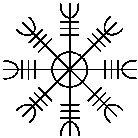
Ægishjálm: the "Helm of Awe" According to a Scandinavian belief this symbol could strike fear into the hearts of enemies, it was painted on the forehead between the eyebrows before a battle and everybody who saw it would flee in terror.
An alternative version of the belief was that the user should recite "Ægishjalm eg ber milli bruna mjer" ("Ægishjalm I carry between my brows") after which victory was achieved, in that case it would have had a magical meaning.
The symbol has been used in Northern Europe for thousands of years and there are different versions of the Ægishjálm; there are very simple versions and very complex ones, it is believed that it also had a higher meaning; each symbol in the sign had a symbolical meaning that represented certain cosmic energies.

Apple: the apple is a very old fertility symbol, it is edible and it falls from a tree to create a new tree.
The apple was a holy symbol to both the Germanic and Celtic religions, it was associated with youth and probably also with the Dísir.
Apples were placed on altars that were dedicated to fertility gods/goddesses, in Germanic mythology there was also a woman named Idun or Idunna who created apples of youth by dipping them into a magical well after which she gave them to the gods every day to keep them young.
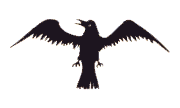
Raven: the raven was associated with the god Wodan, who had two ravens named Huginn ("Memory") and Muninn ("Thought"); according to Germanic mythology this two birds flew over the nine worlds every day after which they would land on Wodan's shoulders to tell him what they had seen, one of Wodan's Old Norse nicknames was Hrafnagud ("Raven's god").
The raven was associated with battle, death, and victory, some Viking leaders carried a raven banner into battle because they believed it would make an army invincible for its enemies.

Eagle: the eagle was the symbol of the Goths, who probably adopted it from the nomads they encountered in Russia and eastern Europe.
The eagle has always caught the imagination of humans and has been used by many peoples throughout history, nowadays it is still used by many countries like for instance the United States, Germany, Austria, Poland, and Russia.

Boar: the boar was a fertility symbol that represented abundance and protection, it was linked to a number of gods, especially to Frey and Freya.
The boar was also a symbol of strength and it was sometimes worn on helmets, the boar also had a prominent place in the Celtic religion.

Ship: the ship symbol was already used in rock carvings dating back to 5000BC, the most famous ones can be found on rock drawings in Sweden.
The ship symbol was also used in funeral rites because it was believed that either a ship or a wagon would carry the dead towards the afterlife, a similar belief can be found in Greek mythology where the dead were transferred over the river Styx by a ferry.
The ship is also a fertility symbol of which most are associated with the Vanir (Wanen) family, especially the god Njord/Nerthus, Tacitus also mentioned that the Suebians worshipped the goddess Isis (who was equalled to Freya) and that her symbol was a light warship.

Trefot: the Trefot (Germanic: "three-feet") or Triskelion (Celtic) is a moon symbol and its three feet symbolize the three stages of the moon.
It was associated with Wodan and it may be possible that it was also a variation of the Walknot or the Sunwheel.
There are several versions of this symbol ranging from a hooked cross to a swirling one.



Sunwheel: due to an evil maniac who lived over half a century ago many people still associate this symbol with evil and bloodshed, the Sunwheel, also known as the Fylfot ("much-feet") was a holy symbol to most of the ancient cultures, it represented the sun and it was originally a symbol of goodness and life. (its other name;"Swastika" is Sanskrit for "Good Fortune")
In the Germanic religion the Sunwheel also represented power and lightning.
The Swastika is one of the oldest holy symbols known in the world; it was used by the ancient civilizations of Europe, the Middle East, Asia, Northern Africa, and even in the America's, in the ancient world the Swastika was to most religions what the Cross is to Christianity or the Half Moon to Islam.
It was related to the Suncross and there were also combinations of them both, in Germanic religion the symbol was linked to the god Thunar and the Celts associated it with Taranis; the Celtic god of Thunder, it was also holy to the Indians, the Chinese, the Native Americans, and the Slavs, and it is still holy to the Hinduistic religion today.
There were also Sunwheels with 6 or 8 feet, and sometimes dots were included in the symbol, which probably represented stars.
- Manwoman.net is an organization that is trying to reclaim this symbol of Goodness from the nazi's and other extremists who abuse it, their website can be found at: http://www.manwoman.net/swastika
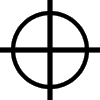





Suncross: this symbol is closely related to the Sunwheel and is often called like that too, something that is very confusing so the best name to use for this symbol is Suncross.
The Suncross represents the sun and the seasonal cycles of the year, on Midsummer the people rolled burning Suncrosses down hills, this was probably done to represent the sun's orbit in the sky, just like the Sunwheel the Suncross is a very old symbol that was used by many cultures, it has even been found on rock carvings from the Stone Age.

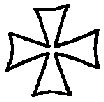

Cross: the cross is one of the oldest human symbols and was used by our ancestors in various forms, type 1 is the most common form but types 2 and 3 have also been found on Scandinavian rune stones.
It is believed that the cross was originally a sun symbol and a representation of the two solstices and two equinoxes of the year, but this remains speculative.
It is known however, that the most important (pre-Christian) meaning of the cross was giving protection against evil spirits, bad luck, witches, and nightmares, and for this purpose the cross was often used in religious depictions and protective amulets.
Later the cross was adopted by Christianity as a referation to the cross of Jesus, the belief that a cross repulses evil beings like vampires and werewolves also has a pre-christian origin.
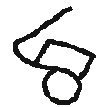
Wagon: the wagon was an invention that allowed large quantities of food and goods to be transported, which was of great use to the Germanic tribes during the Great Migrations.
The wagon is often linked to the Vanir gods like for instance Frey whose idol was carried around in a wagon as part of his rite, Tacitus mentions a ritual held by the Frisians who rode an idol of the goddess Nerthus in a wagon through the village towards a holy swamp, the wagon was also used by many gods to ride through the sky or travel to other worlds.
Just like the ship, the wagon was seen as a transport to the afterlife.
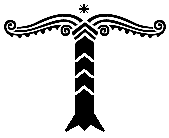
Pillars: in Germanic religion pillars often represented the world tree Yggdrasil, they were also raised to honour the gods and a good example of a pillar is the Irminsul ("Enormous Pillar"), which was worshipped by the Saxons who saw it as the center of the universe, pillars were sometimes believed to divide the heavens from the earth and were used for interaction with the gods, many tribes had their own Sul ("Pillar") that was often dedicated to the patron god of that tribe.
The pillar was also a fertility symbol and they are even believed to have represented a phallus, in some places in India the people still worship pillars representing a phallus that fertilizes the earth.


Wolfsangel: the Wolfsangel ("wolf-hook" or "wolf-angle") was a symbol that represented the wolf and it was believed that anyone who wore it during a battle would receive the power and strenght of a wolf, it was associated with werewolfs and the Ulfheiðr.
It was also associated with the Sowilo rune and with thunder; an alternative German name for this symbol was "Donnerkeil" (Thunderbolt)
There were many different types of the Wolfsangel but they all had the same meaning.
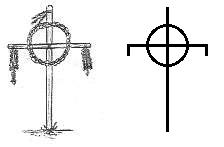
 Questenbaum: this symbol was made of twigs and oak leafs though it is also believed that there was a graphical version of it, according to some sources it represented war, order, and organized society, though a more plausible explanation is that it was originally a fertility symbol that was used during the Spring celebrations; it was probably an alternative version of the Maytree or Maypole, which was raised during this celebrations, the custom of raising a Questenbaum is still practiced in some rural areas of Germany where it is also raised during the Spring celebrations.
Questenbaum: this symbol was made of twigs and oak leafs though it is also believed that there was a graphical version of it, according to some sources it represented war, order, and organized society, though a more plausible explanation is that it was originally a fertility symbol that was used during the Spring celebrations; it was probably an alternative version of the Maytree or Maypole, which was raised during this celebrations, the custom of raising a Questenbaum is still practiced in some rural areas of Germany where it is also raised during the Spring celebrations.This symbol may also have been related to the Suncross.

Black Sun: the Black Sun was probably a bindrune of 12 sowilo runes that represented the rays of the sun, it was a cosmic sign that symbolized the eclipse and sometimes even the end of the world (Ragnarök), it also symbolized death and rebirth and was also used by the Babylonians and the Assyrians.
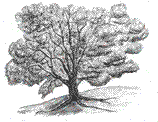
Tree: big and old trees were considered holy in Germanic religion, especially oak trees were believed to contain magical powers; in Germanic mythology there were nine worlds that were carried by the world-tree Yggdrasil, it was also believed that some trees were inhabited by spirits.
The Germans often dedicated trees to certain gods and throughout northern Europe there were trees dedicated to the god Wodan (Odin) or Thunar (Thor/Donar), some of this trees still stand today but most of them have been replanted at least once on the place of the older one since most trees don't reach an age of 1000 years or more.

Nine Worlds: this double Algiz rune represents the world tree Yggdrasil and the Nine Worlds, the sidebranches symbolize the roots and the leafs.

Donderbezem: the Donderbezem or "Thunderbroom" as it literally means, was often used in the Netherlands and western Germany, especially by the Saxons, it was connected to the god of thunder (Thunar/Donar/Thor) and many people attached it to their house because it was believed that it would then be protected by him, originally the Thunderbroom was a bundle of twigs but later this abstract symbol was also used, after the Christianization of Europe the use of this symbol continued and it was often integrated into the brickwork of the house, though this was mostly done in the form of a tree, mill, or human figure.
Originally the broom also protected against lightning and evil spirits and was connected to the Hagalaz rune.
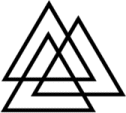
Walknot: also known as "Valknut", which means "Knot of the Fallen", it was associated with Wodan and it symbolized the binding of the soul, other meanings of it were probably Fate and Action/Recation, a person who carried this symbol had dedicated himself to Wodan and was willing to die at his command, it also gave Wodan the power to influence his live; both in a positive and negative way.
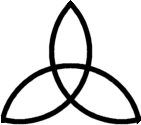
Triqueta: the Triqueta is connected to the Walknot and it probably represents dynamic energy, it was mainly used by the Anglo-Saxons and the Frisians and it seems to have also been associated with the god Frey.
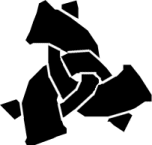
Horn triskelion: this symbol is related to the Walknot, the Trefot, and the Triqueta.
It is probably derived from the Scandinavian legend in which Odin (Wodan) obtained the mead of inspiration from a frost giantess, he slept with her for 3 nights and every night he was allowed to drink one horn of the mead, the 3 horns are named; Wódroerer, Boðin, and Son.

Horse: the white Horse was a symbol that represented Sleipnir; the eight-legged horse of Wodan, it is the best of all horses and it is able to cheat death so that it can be used to travel to the afterlife (Helheim) and back, it was associated with death and rebirth.
The horse was also sacred to the god Frey.

Spear: the spear was the most common weapon used by Germanic warriors, it was associated with Wodan who carried a spear named Gungnir and just like the hammer symbol it was worn as a pendant to receive protection from a god, in this case this god was Wodan.
At the beginning of a battle a decorated spear dedicated to either Tiwaz or Wodan was thrown over the heads of the enemy to sacrifice the ones that would die to the wargod and to receive the favour of the god it was dedicated to.
The spear throwing ritual may have also been used to hallow the battlefield.

Footprint: the footprint is a symbol of the god Njord/Nerthus, it may have been derived from the Scandinavian legend in which the god Thor (Thunar) killed the father of a Frost Giantess named Skadi, as retribution she was allowed to choose one of the gods as her husband, the trick was that the gods were positioned behind a curtain and that she had to pick one by looking at their feet, she chose the most beautiful feet hoping that they belonged to Balder, but the god attached to them turned out to be Njord.
The footprint was associated with fertility and the Vanir (Wanen) gods.

Heart: the heart is a fertility symbol dedicated to the god Frey and maybe also to Freya; it symbolizes the private parts of a woman and was probably connected to love and sexuality, it was already used in Cro-Magnon cave paintings that are thousands of years old.

Lime leaf: the leaf of the Lime tree ("Linde" in most other Germanic languages) probably resembled fertility, it also had much similarities with the Heart symbol, probably due to its form.
There is also a symbol on the weapon and flag of the Dutch province of Frisia that is called "Plompeblad" (Dutch) or "Meerblad" (Frisian), which has much in common with the Lime leaf symbol and is probably a distortion of it.
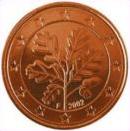
Oak leafs: in the Germanic countries oaks leafs have been used througout history, especially in Germany where it became one of the national symbols as can be seen on this German coin of 2 Eurocents.
The original meaning of oak leafs is not entirely sure but the oak itself was considered to be a holy tree connected to the gods Wodan and Thunar, wreaths of oakleafs were also used in fertility ceremonies.
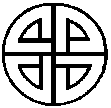
Shieldknot: the shieldknot probably symbolized protection or defence, there are many versions of the shieldknot; knotted and intertwined designs often occur in Germanic art and it may represent the believe that everything is this world is intertwined by Wurðís ("fate"), and that every action has a reaction.

Cross of st. Hans: this symbol, which is nowadays known as the st. Hans or st. John cross, was used on Scandinavian rock paintings, in later times it was connected to cabbalistic magic and zodiac signs though it was probably an alternative version of the shieldknot.

Key: the key was the symbol of Frigg, the wife of Wodan/Odin.
She was the head of the household and it was a custom to give the keys of the house to the wife.
The key also symbolizes access to normally inaccessible terrains, it forces a breakthrough thus it was seen as a way to solve problems.
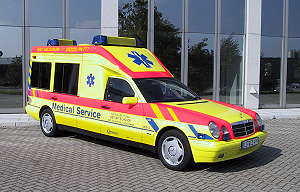
Cross of st.Andreas: the st.Andreas-cross or st.Andrews-cross is associated with a Christian saint called Andreas, many hospitals still use this symbol and it can often be seen on ambulances.
The st.Andreas cross is a Christianized version of a Medieval variation of the Hagalaz rune and just like its Heathen predecessor it is associated with protection, this protection is nowadays believed to be given by st.Andreas though the original protector was Thunar, it's funny to know that many of the patients travelling in ambulances are still receiving protection from our ancient thundergod.

Symbol of the Moongod: this symbol was connected to the Ingwaz rune and was used by some Germanic tribes to represent the Moon god, it is unknown whom of the gods this title refered to though it was probably Frey or Tanfana.

Todesrune: the Todesrune ("Death-rune") represented death and was probably connected to the Tiwaz rune.

Hex sign: the Hex sign, also known as "Six-star" is an alternative version of the Sunwheel, it symbolizes movement and resembles a flower, which may have some link to fertility, it is also a sign to ward off evil powers.

Eye of Fire: not much is known about this symbol, it is of an old origin and propably represented fire, it may have been used to represent the element of fire in runic charms and it could have been associated with Loki.
Another theory is that it represented the fiery eye of Hel, the goddess of the Afterlife, with this eye she could see the truth and nothing was hidden from her.

Housemarks: a housemark was an ownership symbol symbol was attached to houses and property, there were unlimited varieties of this symbols and they had much in common with runes.
The housemarks are of early Germanic origin and the oldest known human ownership symbols, they were the predecessors of the Medieval heraldic symbols and also predated the family weapons that later replaced them, analphabethic people also used them as a signature which implicates that the housemarks may have originally been bindrunes.
Clog almanacs:
Clog almanacs were Scandinavian calendars that were used during the Middle Ages, they were based on older moon calendars and most of the signs used on that calendar were of heathen origin and were changed after the arrival of Christianity in Scandinavia.

Symbol of Spring: this symbol represented the season of Spring.

Symbol of Summer: this symbol represented the season of Summer.

Symbol of Autumn: this symbol represented the season of Autumn.

Symbol of Winter: this symbol represented the season of Winter.


Beginning of summer: this sign symbolized the beginning of the summer half-year, the period that started on the day of Tiburtius (April 13) and lasted to October.

Day of Tibertius: this sign symbolized the day of Tiburtius, a saint who did missionary work in Sweden.
The day dedicated to him was April 13 on which the Summer half-year started.

Mooncycle symbol: this symbol represented the golden number 18 that could be used to calculate the cycles of the moon, and the dates of full moon, new moon, and eclipes.

Spring equinox: this symbol represented Annunciation Day, which was the day of the spring equinox.


Autumn equinox: this symbol represented Michaelmas, which was the day of the autumn equinox and the first day of the winter half year.

Virgin Mary: this symbol represented all days that were connected to the Christian virgin Mary, some of this days may have once been connected to Germanic goddessess.

Number 5: this symbol represented the golden number 5, notice the similarity with the Thurisaz rune.

Number 10: this symbol represented the golden number 10.

Number 15: this symbol represented the golden number 15.


Number 17: this symbol represented the golden number 17.
Other clog signs:
 : In clog almanacs the Thurisaz rune was associated with Wednesday.
: In clog almanacs the Thurisaz rune was associated with Wednesday. : In clog almanacs the Ansuz rune was associated with Thursday.
: In clog almanacs the Ansuz rune was associated with Thursday. : In clog almanacs the Raiðo rune was associated with Friday.
: In clog almanacs the Raiðo rune was associated with Friday. : In clog almanacs the Kenaz rune was associated with Saturday.
: In clog almanacs the Kenaz rune was associated with Saturday. : In clog almanacs the Hagalaz rune was associated with Sunday.
: In clog almanacs the Hagalaz rune was associated with Sunday.Medieval runic symbols:
During the Middle Ages many people in northern Europe still used semi-runic symbols for healing, magic, and protection.
This symbols were probably derived from runic writings and/or old Germanic symbols, most of them represented heathen gods and goddessess and thus had to be used secretly because users of heathen magic were sentenced to death by the church.

1. Wolfsangel; this symbol is probably derived from the older Wolfsangel symbol, it was used for protection against negative energy.
2. Erda; this symbol represented the Germanic earthgoddess Erda (Also known as Frigga, Holda, Berchta, etc.), it was used to re-unite the humans with the earth
3. Ul; this symbol represented a turning point and was used for reviving former powers and healing.
4. Ziu; this was the symbol of the wargod Ziu (Tiwaz) and it was used to channel cosmic energy and maintaining order.
5. Sol; this symbol represented the sun and its warmth and healing powers.
6. Wendhorn; symbolizes the phases of the moon and reminds that one has to experience both the positive and the negative sides of life.
7. Fyruedal; represents the power of motivation.
8. Wan; represents emptyness and the ancient powers from the place from which all existence originates.
Icelandic magical symbols:
After the Christianization of Iceland the use of magic was forbidden by the Christian rulers, however, the practice of old heathen magic continued in secrecy and many people used runic symbols and magical staves for all kinds of magical purposes, I have described some of those symbols below:

Kaupaloki: this symbol was carved on a tablet of beech wood and had to be carried on ones breast, it was believed to bring good luck in business and trade.

Draumstafir: this sign had to be carved on silver or white leather during Midsummer's night, a person who slept on it would have pleasant dreams when the sun was close to the horizon.
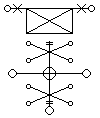
Stave to raise the dead: this symbol was used to drive away evil spirits, destroy ghosts, and to wake the dead; it had to be carved on the skin of a horsehead with a mixture of human blood, seal blood, and fox blood, after that this charm had to be recited:
Þykkt blóð, þreytast rekkar.
Þjóð mörg vos öld bjóða,
grand heitt, gummar andast,
glatast auður, firrast snauðir.
Hætt grand hræðast dróttir
hríð mörg, vesöld kvíða,
angur vænt, ærnar skærur.
Illur sveimur nú er í heimi.

Þjófastafur: this symbol could be used to find a thief; if someone has stolen from you, you could carve this stave on the bottom of a wooden bowl, fill it with clean water, and sprinkle yarrow over it, after that the following charm had to be recited:
I invoke the nature of the grass and the power of the sign to reveal who has stolen from me and others. In nomine domini amen.
After that the face of the thief will appear in the water of the bowl.
The last sentence of the charm shows Christian influences; "In nomine domini amen" is Latin and means "In the name of the Lord amen", it was probably added later to legalize its use.
housefront signs:
In ancient times our heathen ancestors put symbols on the rooftips of their houses, this symbols had all kinds of meanings like defence against lightingstrikes or evil spirits, fertility, prosperity, etc.
In many northern European countries, especially in the Saxon areas of Germany and the Netherlands one can still find this housefront signs, this signs are often mixed with Christian symbols though many of them are heathen in origin like the thunderbroom and the Odal rune
 (Oþala), the amount of symbols and combinations of them is almost limitless, below you can see some examples of Saxon housefront signs:
(Oþala), the amount of symbols and combinations of them is almost limitless, below you can see some examples of Saxon housefront signs: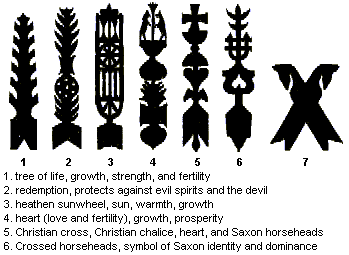
Examples:
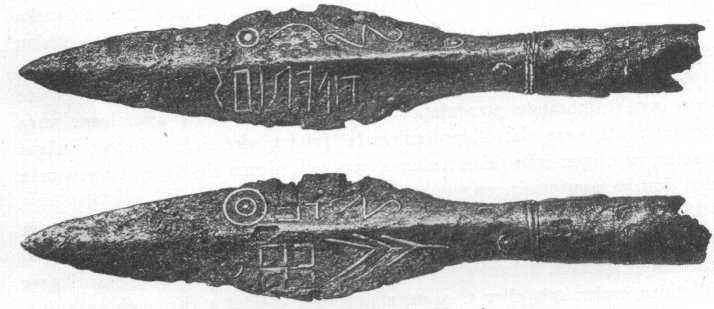
This Gothic speartip has been found near the Ukrainian town of Suszyczno, it is covered with runes and symbols of which some of their meanings are still unclear.
The target-like cirles you see probably represent the sun and the triple "Y" sign on the lower picture is probably a bindrune of three Algiz runes, on the lower picture is also a sunwheel.
The dome-shaped symbol, the symbol with the crossing lines, and the symbol that looks like two opposing 2's are unknown to me.
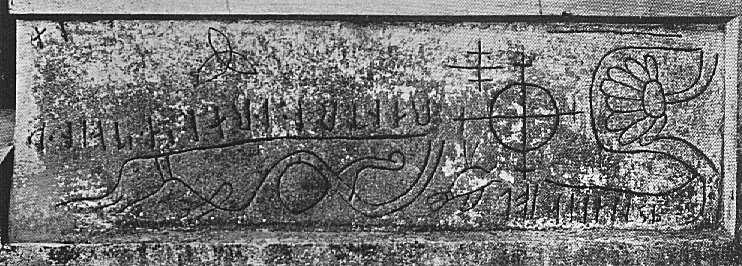
This Danish runic inscription has been found in Getinge, Halland, Sweden; an area that once belonged to Denmark.
It shows a picture of a flower, a Suncross symbol, a Triqueta symbol, and several other signs.
No comments:
Post a Comment